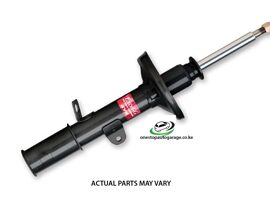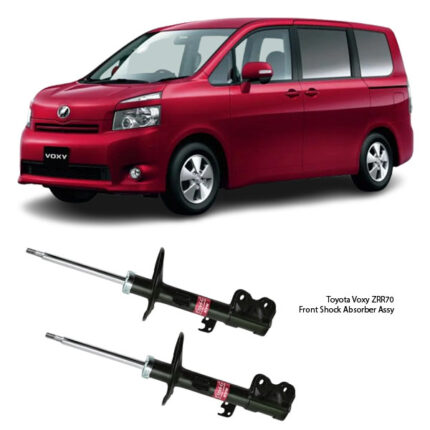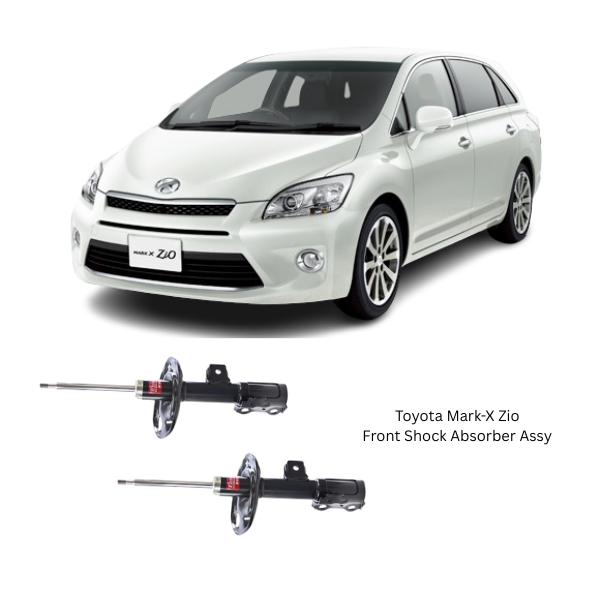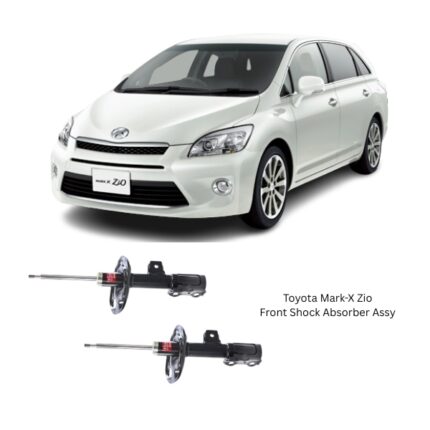Get Toyota Mark-X Zio Front Shock Absorber Assy 335051 in Kenya
A shock absorber is a vital component of a vehicle’s suspension system. Its main job is to control the movement of the suspension and springs, keeping the tires firmly on the ground to ensure a stable, safe, and comfortable driving experience. Though often overlooked, shock absorbers play a crucial role in vehicle handling, braking performance, ride comfort, and overall safety.
This guide outlines all the essential facts you need to know about shock absorbers, including what they do, how they work, signs of wear, and when to replace them.
What is a Shock Absorber?
A shock absorber, often referred to simply as a “shock,” is a mechanical or hydraulic device designed to absorb and dampen shock impulses. It achieves this by converting kinetic energy from the movement of the vehicle’s suspension into thermal energy, which is then dissipated through hydraulic fluid. The primary goal of the shock absorber is to control the oscillation of the vehicle’s suspension system.
Without shock absorbers, a vehicle would bounce uncontrollably after every bump or dip in the road. Tires would lose contact with the surface, steering would become unpredictable, and the overall driving experience would be harsh and unsafe.
How Does a Shock Absorber Work?
Shock absorbers work by resisting the motion of the suspension. Most modern vehicles use hydraulic or gas-charged shock absorbers. When a vehicle hits a bump, the suspension moves up and down. The shock absorber contains a piston that moves through a cylinder filled with hydraulic fluid or pressurized gas. As the piston moves, it forces the fluid through small holes and valves, which restricts the movement and slows down the suspension.
This controlled resistance prevents excessive bouncing or swaying. By slowing down the motion, the shock absorber keeps the vehicle stable and the tires in contact with the road.
There are two common types of shock absorbers:
-
Twin-Tube Shock Absorber: This type features an inner tube filled with oil and an outer tube that stores excess fluid. It is generally used for comfort and standard road handling.
-
Mono-Tube Shock Absorber: This type has a single tube containing oil and a gas charge separated by a floating piston. It provides better performance and heat dissipation, often used in high-performance or off-road vehicles.
Why Shock Absorbers Are Important
Shock absorbers affect several key aspects of vehicle performance:
-
Ride Comfort: They reduce the impact of road irregularities, such as bumps, potholes, and rough terrain, providing a smoother driving experience for passengers.
-
Handling and Stability: Shock absorbers help maintain tire contact with the road, which is crucial for predictable handling, turning, and cornering.
-
Braking Efficiency: By preventing the front of the vehicle from diving excessively during braking, shock absorbers contribute to shorter and more controlled stopping distances.
-
Tire Wear Reduction: When the suspension is properly controlled, the tires wear more evenly. This helps extend tire life and improve vehicle performance.
-
Protection of Suspension Components: Excessive bouncing or uncontrolled suspension movement can damage other parts, such as springs, struts, control arms, and bushings. Shock absorbers help reduce strain on these components.
-
Safety: Properly functioning shock absorbers allow the driver to maintain control during emergency maneuvers, reduce swaying in crosswinds, and prevent loss of traction on wet or uneven roads.
Common Signs of Worn or Failing Shock Absorbers
Like any mechanical component, shock absorbers wear out over time. When they fail or start to lose effectiveness, they can compromise your vehicle’s performance and safety. Here are the most common signs of worn shock absorbers:
-
Excessive Bouncing: If the car continues to bounce after hitting a bump or dip, the shocks may no longer be controlling the suspension movement properly.
-
Nose-Diving When Braking: If the front of the vehicle dips noticeably during braking, it may be a sign the front shock absorbers are worn out.
-
Uneven or Rapid Tire Wear: Shock absorbers that fail to maintain consistent tire contact with the road can lead to patchy or cupped tire wear patterns.
-
Poor Steering Response: If the vehicle feels unstable or hard to control during turns or lane changes, the shocks may not be supporting proper handling.
-
Swerving or Swaying: A vehicle that leans excessively during cornering or is easily affected by side winds may have failing shocks.
-
Leaking Fluid: Hydraulic shock absorbers contain fluid to dampen motion. If oil is leaking from the shock body, the unit is likely damaged and should be replaced.
-
Knocking or Clunking Sounds: Worn shocks can cause metal-on-metal contact within the suspension, leading to unusual noises while driving over rough roads.
How Long Do Shock Absorbers Last?
The lifespan of a shock absorber depends on driving conditions, vehicle usage, and maintenance. On average, shock absorbers should be inspected or replaced every 60,000 to 80,000 kilometers. However, this can vary significantly based on factors like:
-
Driving on rough or unpaved roads
-
Frequent carrying of heavy loads
-
Aggressive driving style
-
Exposure to extreme temperatures or weather conditions
Regular inspection during routine service intervals is essential. If one shock absorber is worn, it’s advisable to replace both shocks on the same axle (either front or rear) at the same time to maintain even performance and balance.
Maintenance and Care
While shock absorbers do not require frequent servicing, periodic inspection is key to ensuring they are in good condition. Here are a few maintenance tips:
-
Check for visible leaks or damage during oil changes or tire rotations.
-
Listen for unusual noises while driving over bumps.
-
Monitor tire wear for irregular patterns.
-
Pay attention to how the vehicle feels during acceleration, braking, and turning.
Replacing worn shocks in a timely manner prevents additional wear on tires and suspension parts, saving money in the long run and ensuring continued driving safety.
Follow us on Facebook for more parts.




